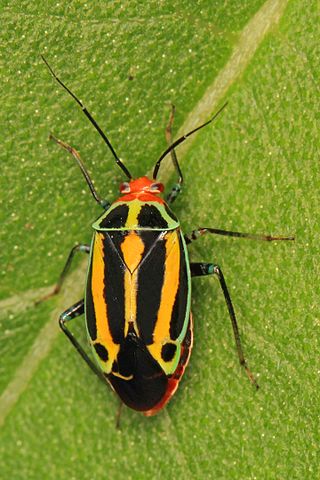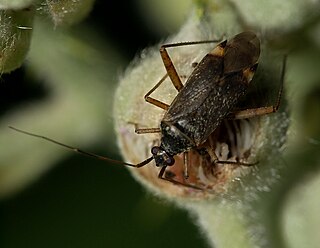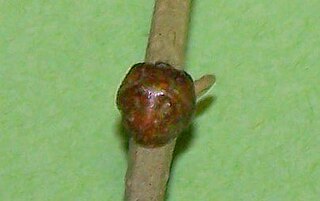
Hemiptera is an order of insects, commonly called true bugs, comprising over 80,000 species within groups such as the cicadas, aphids, planthoppers, leafhoppers, assassin bugs, bed bugs, and shield bugs. They range in size from 1 mm (0.04 in) to around 15 cm (6 in), and share a common arrangement of piercing-sucking mouthparts. The name "true bugs" is often limited to the suborder Heteroptera.

The Miridae are a large and diverse insect family at one time known by the taxonomic synonym Capsidae. Species in the family may be referred to as capsid bugs or "mirid bugs". Common names include plant bugs, leaf bugs, and grass bugs. It is the largest family of true bugs belonging to the suborder Heteroptera; it includes over 10,000 known species, and new ones are being described constantly. Most widely known mirids are species that are notorious agricultural pests that pierce plant tissues, feed on the sap, and sometimes transmit viral plant diseases. Some species however, are predatory.
Martial Jean Maurice Noualhier was a French entomologist who specialised in Hemiptera.

Gargaphia solani is a subsocial species of lace bug commonly known as the eggplant lace bug. The species was described by Heidemann in 1914 after it aroused attention a year earlier in the United States as an eggplant pest around Norfolk, Virginia. Fink found that the species became an agricultural pest when eggplant is planted on a large scale.

Macrotylus quadrilineatus is a species of plant bug belonging to the family Miridae, subfamily Phylinae.

Lygocoris rugicollis is a widespread, common species of bug in the Miridae family. It feeds on a large variety of bushes and small trees, but especially willows and slightly less often alders. It can be found throughout Europe, including the UK, and Spain, in North Africa, as far east as Central Asia, in Alaska and Canada, including the Maritimes.

Poecilocapsus lineatus, commonly known as the Fourlined Plant Bug, is a species of true bug (Hemiptera) in the family Miridae. This species is native to the United States and Canada.

Closterotomus is a genus of plant bugs belonging to the family Miridae, subfamily Mirinae.

Closterotomus fulvomaculatus is a species of plant bugs of the family Miridae, subfamily Mirinae.

Closterotomus norvegicus is a species of bugs belonging to the family Miridae, subfamily Mirinae. It can be found feeding on nettle, clover, and cannabis, as well as Compositae, potatoes, carrots and chrysanthemums. They prefer to feed on the flowers, buds and unripe fruit. The species occurs in the Palearctic-British Isles and east across continental Europe to Siberia. It also occurs in the Nearctic as an adventive species. In 1997 it was moved from the genus Calocoris to its current name.

Tytthus is a genus of insects in family Miridae, the plant bugs. They are carnivorous, feeding upon the eggs of various planthoppers in the family Delphacidae, and thus are important in the biological control of pests. The genus is distributed throughout the Holarctic of the Northern Hemisphere, but species are also found in the tropics, in China, South America, Australia, and the Indo-Pacific.

Phylus melanocephalus is a European species of plant bugs belonging to the family Miridae, subfamily Phylinae. It is a slender bug 4.5–6 millimetres (0.18–0.24 in) long and feeds on oak trees. Its colour ranges from orange to greenish-brown and its head may be pale or dark.
Dicyphus hesperus is a species of true bug in the family Miridae. It is a generalist predator of other insects and also feeds on plant tissues. It is native to North America and has been used there in biological control of agricultural pests, especially whitefly on tomatoes.

Taylorilygus apicalis or broken-backed bug is a species of plant bug in the family Miridae.

Creontiades dilutus, commonly known as the green mirid, is a member of the bug family Miridae. This insect is considered a "generalist" feeding on over 100 plant species, and is also a major economic pest on several important agricultural crops.

Arocatus melanocephalus, the elm seed bug, is a true bug in the family Lygaeidae. The species was initially described by Johan Christian Fabricius in 1798, and Maximilian Spinola designated it to be the type species of the genus Arocatus in 1837. This bug is native to Europe but has been introduced to North America.

Macrolophus is a genus of plant bugs in the family Miridae. There are at least 20 described species in Macrolophus.
Deraeocoris brevis is a species of predatory plant bug in the family Miridae. It is native to North America where it feeds on plant pests in apple and pear orchards.

Saissetia oleae is a scale insect in the family Coccidae. It is considered one of the three main phytophagous parasites of the olive tree, together with the olive fruit fly and the olive moth. Although it is a common parasite which occurs most often in olive trees, it is a polyphagous species, also attacking citrus trees as well as various ornamental shrubs such as oleanders, pittosporums, sago palm, and euonymus.

Nagusta goedelii is a species of assassin bugs in the family Reduviidae.


















